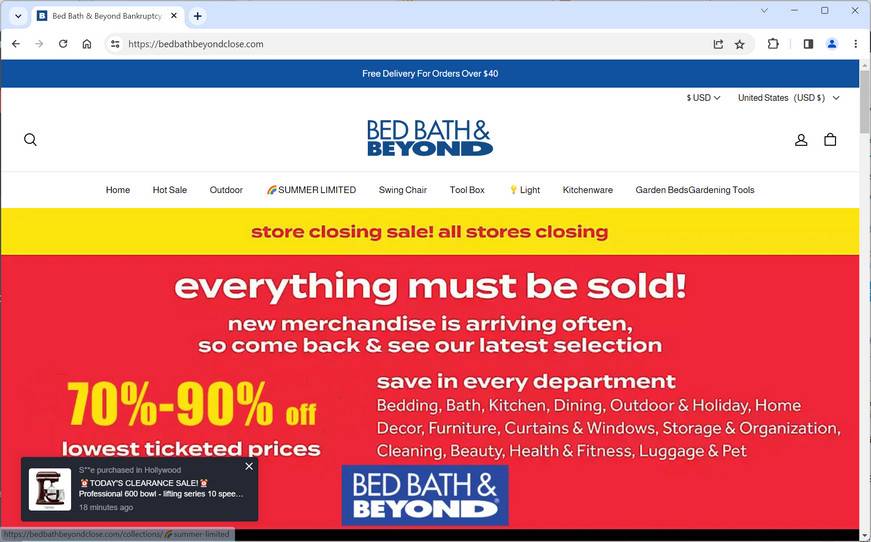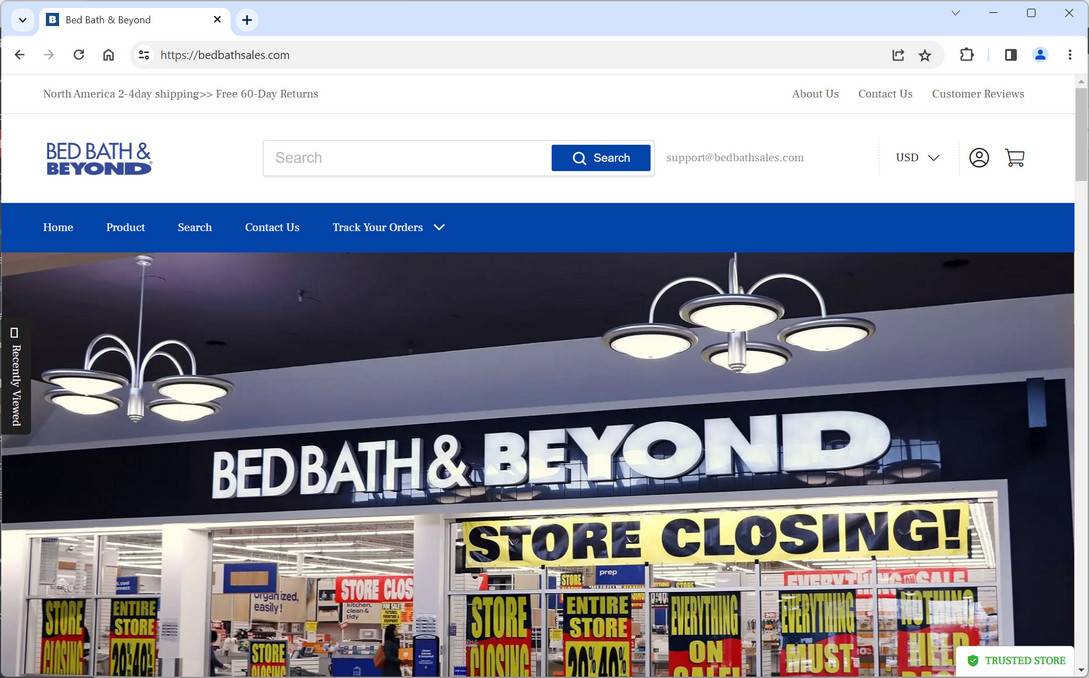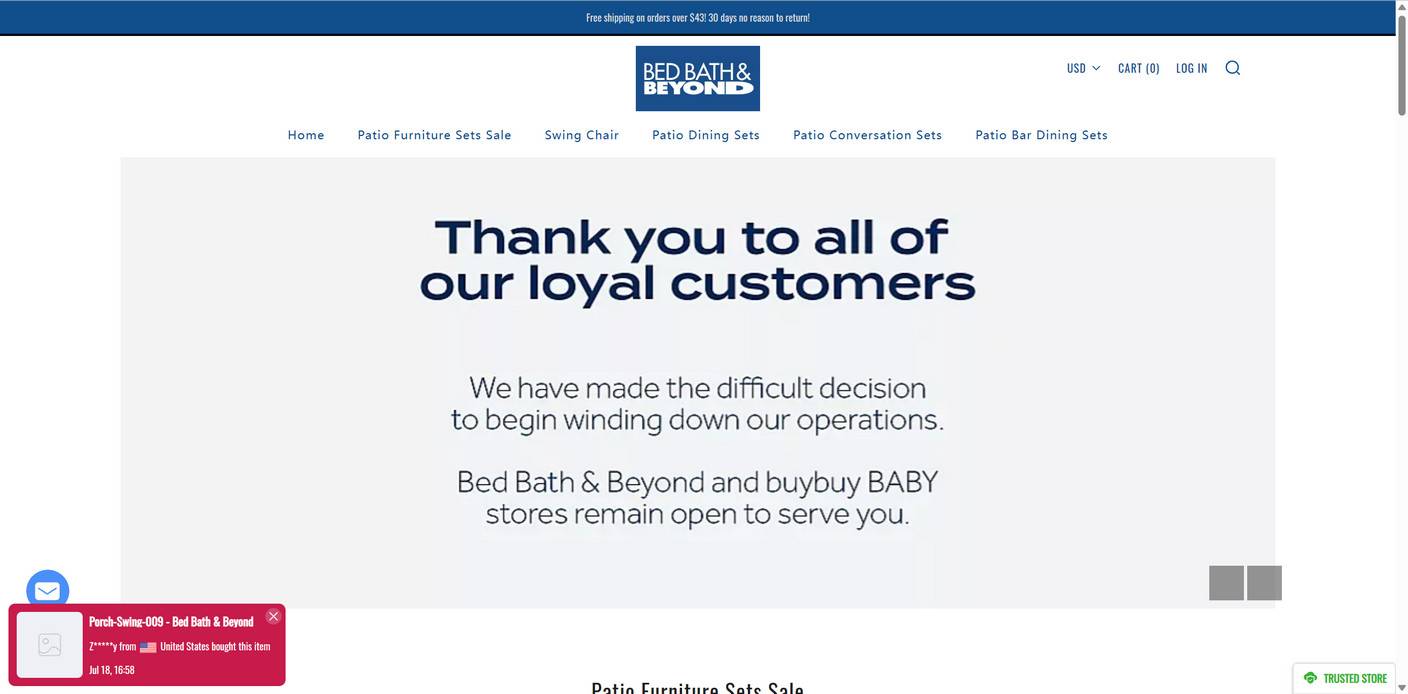With the recent news that Bed Bath & Beyond has filed for bankruptcy and will begin closing its remaining stores, fraudulent websites have popped up impersonating the brand and falsely claiming huge liquidation sales. However, these sites are complete scams aiming to steal money and information from shoppers. This article will break down exactly how the “Bed Bath & Beyond All Stores Closing” scam works, tips for avoiding it, and what to do if you were unfortunately deceived.
What is the “Bed Bath & Beyond All Stores Closing” Scam?
The “Bed Bath & Beyond All Stores Closing” scam refers to fraudulent websites that have been proliferating online and impersonating major retailer Bed Bath & Beyond.
The main purpose of these “Bed Bath & Beyond closing” phishing scams is to deceive customers into providing their personal and payment information during checkout on the fake sites.
Scammers operating the fraudulent sites then steal identities, commit payment fraud, or resell the harvested information illegally. No real products are ever shipped to victims who place orders despite confirmation emails with fake tracking numbers.
How the Fake “Bed Bath & Beyond All Stores Closing” Scam Works
The fraudulent Bed Bath & Beyond All Stores Closing websites operate by deceiving shoppers in a few key ways:
- The scam sites are made to mimic the real BedBathandBeyond.com ecommerce site using official logos, images, and branding.
- They claim that due to the bankruptcy, Bed Bath & Beyond is permanently closing all remaining brick-and-mortar stores and liquidating all merchandise at prices discounted 40-90% off.
- Prices shown are at huge reductions compared to normal rates, and countdown timers create false urgency about limited supply.
- When customers purchase something, their personal and payment data is harvested during checkout by the scammers operating the sites.
- After checkout, victims receive an order confirmation email with a fake tracking number, but no order is ever fulfilled and the “tracking” never updates.
- Any attempt to contact the sites about the delayed order results in ignored messages or disconnected phone numbers. No refunds are issued.
The scam capitalizes on the brand recognition of Bed Bath & Beyond to fool shoppers into believing they are getting unbelievable liquidation deals when in reality they are handing money and information directly over to scammers.
Warning Signs of “Bed Bath & Beyond All Stores Closing” Scam Sites
Although the Bed Bath & Beyond All Stores Closing scam websites promote convincing closing sales, they generally exhibit these red flags:
- Claims of store closings and liquidations with no verifiable proof of authorization from the real company.
- Advertising prices far below reasonable liquidation sale discounts, like 90% off.
- Use of countdown timers, limited quantities, or other scarcity pressures to compel quick purchases.
- URLs that differ slightly from the real BedBathandBeyond.com site, often with extra words.
- Complete lack of legitimate contact information like working phone numbers.
- No established social media ties predating the bankruptcy and closure announcements.
- Offering an overly broad product selection unlikely for a winding down retailer.
- No order shipping confirmation emails from real carriers after checkout completion.
Carefully looking for these signs of a scam can help you avoid being deceived before making a purchase.
Avoiding Bed Bath & Beyond All Stores Closing Scam Website Risks
You can protect yourself from the Bed Bath & Beyond All Stores Closing scam sites by taking the following precautions:
- Only use the official BedBathandBeyond.com website for purchases. Avoid any third-party domains.
- Verify any liquidation sales by calling local stores to confirm legitimacy before acting.
- Analyze sites for the red flags outlined above to identify fraudulent websites impersonating the brand.
- Never pay using unsecure methods like wire transfer, gift cards, or cryptocurrency. Only use credit cards.
- Read online reviews to gauge experiences from other shoppers before purchasing from unfamiliar sites.
- Trust your instincts – if an offer seems fake, or a website looks questionable, avoid the risk.
Sticking to trusted channels and being wary of unbelievable deals prevents you from being scammed.
What to Do If You Already Shared Information With a Scam Site
If you unfortunately already provided personal or payment details to a Bed Bath & Beyond scam website, promptly take these steps:
- Contact your bank/credit card provider to flag the charges as fraudulent so they can be contested. Cancel any compromised cards.
- Place an initial 90-day fraud alert on your credit file with one of the three credit bureaus.
- Monitor your credit reports closely for any signs of new accounts opened fraudulently in your name.
- Change the password on your Bed Bath & Beyond account, email account, and any others that may have reused the same credentials.
- Report the scam to the FTC and IC3 to aid law enforcement in pursuing these frauds.
- Use the incident as a valuable lesson to be more vigilant against online scams going forward.
Acting quickly helps limit any potential damages from stolen personal and financial information used illegally. Do not let embarrassment prevent you from taking steps to protect yourself after the fact.
Why Bed Bath & Beyond Scams Are So Deceptive
Some reasons these phishing scams successfully dupe many shoppers include:
- Bed Bath & Beyond is a well-known and trusted national retail brand, making the premise believable.
- Huge liquidation discounts of 40-90% excite bargain hunters into urgent purchases.
- Countdown timers and limited stock claims produce false scarcity and compel fast action.
- Official logos and images are stolen to initially appear as the real site.
- Shoppers do not expect liquidations to require formal announcements if a retailer is bankrupt.
- Strong motivation to take advantage of deals for needed home items.
Recognizing these psychological tricks and manipulation tactics makes identifying scams faster. Verify real sales on the official company website before trusting third-party claims.
FAQs About the Bed Bath & Beyond All Stores Closing Scam
Is Bed Bath & Beyond really closing all its stores permanently?
Yes, the company filed for bankruptcy and announced remaining locations will close. However, liquidation deals should only be trusted from authorized channels.
How can I confirm a website is really tied to Bed Bath & Beyond?
The real domain is BedBathandBeyond.com. Fake sites use slight spelling changes or add extra words. Verify the URL matches exactly.
Is it illegal to purchase counterfeit goods from the scam websites?
Yes, knowingly purchasing counterfeit trademarked items is illegal and helps fund more scam sites that harm innocent victims.
What should I do if I already provided my information to a scam site?
Immediately contact your bank/credit card company about fraudulent charges. Place fraud alerts on your credit, change account passwords, monitor your credit reports closely, and file complaints with the FTC and IC3.
How can I safely shop the real closing liquidation sales?
Only shop sales advertised on the BedBathandBeyond.com website. Verify any in-store liquidation events by calling local stores before trusting third-party sites.
The Bottom Line
Websites promoting Bed Bath & Beyond liquidation sales, huge discounts, or store closings without verifiable authorization are always fraudulent and should be avoided. They intend only to scam shoppers out of money and steal personal data. Protect yourself by carefully analyzing site details and verifying sales on the real company website before purchasing. Never provide payment or sensitive information to unfamiliar third-party sites exhibiting warning signs of a scam. Exercise caution to steer clear of these prevalent scams during the Bed Bath & Beyond bankruptcy and closure process.













